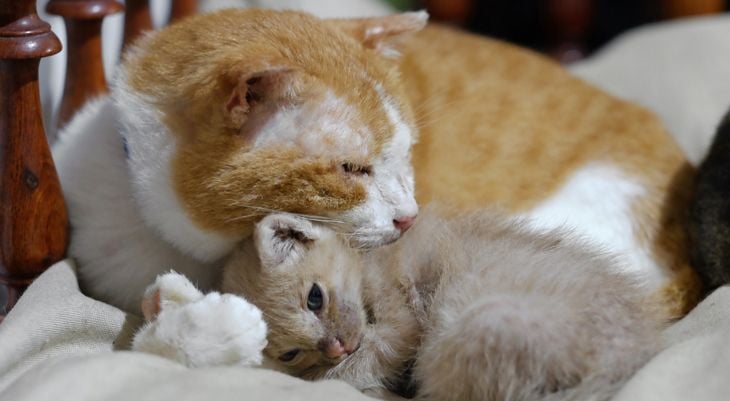
The kidneys have two important roles in a cat’s body. First, they filter wastes and toxins from the blood, which then exit the body in the urine. The kidneys also help regulate the volume of fluids in the body and important hormones and other chemicals.
Cats can develop several kinds of kidney issues, such as kidney stones, kidney disease and high blood pressure. Some of these can be life-threatening if not treated promptly.
Bladder and Kidney Stones
Bladder and kidney stones grow from minerals that are naturally present in a cat’s body. They can develop anywhere in the urinary system, including the kidneys and bladder.
If too much of these minerals are present, small crystals can form in the urinary system. The crystals can stick together and grow into stones. Stones can be made from different kinds of minerals.
Cats that do not drink enough fluids, do not urinate enough and are not active enough are more likely to develop bladder and kidney stones.
Some stones are so small that they pass out of the body in the urine without the cat noticing. Larger stones, though, may irritate the lining of the urinary tract or cause bleeding. Kidney stones may not be noticed until they are much larger.
If a stone is large enough, it can get stuck in the urinary tract. This can partially or completely block the urine from leaving the body. As a result, poisonous wastes build up in the blood. This is a medical emergency. Stones may also increase the risk of infection in the bladder or kidneys.
Symptoms of bladder and kidney stones include:
- Painful urination
- Frequent urination
- Blood in the urine
Kidney and bladder stones can be diagnosed by a veterinarian using X-rays or ultrasound.
Treatment for kidney and bladder stones depends on the type, size and location of the stone and may include:
- Dietary changes that cause existing stones to dissolve and prevents new ones from forming
- Breaking stones apart with a small laser inserted into the urethra. The pieces then pass out on their own in the urine
- Surgery to open up the kidney or urinary tract and remove the stone
To prevent stones from forming, provide your cat with fresh water daily to encourage it to drink regularly. Keep the litter box clean to ensure that it urinates more frequently. Also, make sure that your cat stays active.
Hypertension
Hypertension, or high blood pressure, is common in cats. Left untreated, it can damage a cat’s eyesight or affect the kidneys or heart. It can even be life-threatening. High blood pressure may also be a sign of other health problems.
High blood pressure can show up in cats without any identifiable cause. However, this is rare. More often, high blood pressure results from other health problems, such as:
- Kidney disease
- Overactive thyroid
- Diabetes
- Heart disease
- Tumor that produces excess hormones
- Medications
Kidney disease is the most common cause of high blood pressure in cats. Cats have a higher risk of developing hypertension as they age.
Symptoms of high blood pressure include:
- Eye problems
- Poor appetite
- Weight loss
- Increased drinking and urination
- Being disoriented
- Seizures
- Trouble breathing
Veterinarians can detect high blood pressure during regular wellness visits. If your cat has high blood pressure, the veterinarian will use blood and urine tests to try to identify the underlying cause. These other health problems need to be address alongside the hypertension.
The main treatment for high blood pressure is the use of a medication such as a calcium channel blocker or angiotensin-converting enzyme (ACE) inhibitor. Both of these relax the blood vessels, which causes them to grow wider. This results in a drop in blood pressure.
Polycystic Kidney Disease
Polycystic kidney disease occurs most often in Persian cats and certain other breeds. The exact cause of this condition is not known, but it is inherited, meaning it is passed from parents to offspring.
A cat with this condition develops small, closed sacs (cysts) filled with fluid in the kidneys. Over time, these increase in size and number. Eventually, the sacs can cause the kidney to stop working.
A cat with polycystic kidney disease has these cysts at birth. The sacs are very small in the beginning, but will start to grow and increase in number. This occurs differently in each cat.
Symptoms frequently show up around the age of 7; although this can occur later or earlier for some cats. Sometimes the condition can be diagnosed in kittens as young as 6 months of age.
Symptoms of polycystic kidney disease include:
- Increased drinking and urination
- Loss of appetite and weight
- Nausea and vomiting
- Lack of energy
This condition is best diagnosed using ultrasound. There is no cure, but the symptoms can be managed with:
- Controlled diet
- Medications to control the amount of fluid in the body
- Other medications
Because there is no cure, owners can have their Persian cat tested to see if it carries the gene that causes this condition. If it does, the best way to prevent further suffering is to not breed the cat.
Renal Amyloidosis
Renal amyloidosis is a serious and incurable condition that affects the kidneys in cats. It is rare and almost always occurs in Abyssinian cats and Oriental breeds.
During this condition, abnormal amounts of a fibrous protein substance called amyloid collects in the kidneys. As the amyloid increases, it displaces the healthy kidney tissue.
This makes it more difficult for the kidneys to work and affects their ability to filter wastes from the blood. The kidneys also develop inflammation and start to pass protein into the urine.
Symptoms of renal amyloidosis include:
- Increased drinking and urination
- Loss of appetite or weight
- Swelling in the limbs from fluid retention
- Vomiting
In other kidney diseases, the kidneys may grow smaller. In renal amyloidosis, though, they stay normal in size. The condition can be diagnosed using:
- Blood and urine tests
- X-rays and ultrasound imaging of the kidneys
- Kidney biopsy, or the removal of a small piece of tissue
This condition has no cure. Treatment involves trying to slow down the damage to the kidney using medication and changes to the diet. Cats have the best chance of success when this condition is diagnosed earlier.
Please call our office today if you think your cat might be suffering from any type of kidney problem.
